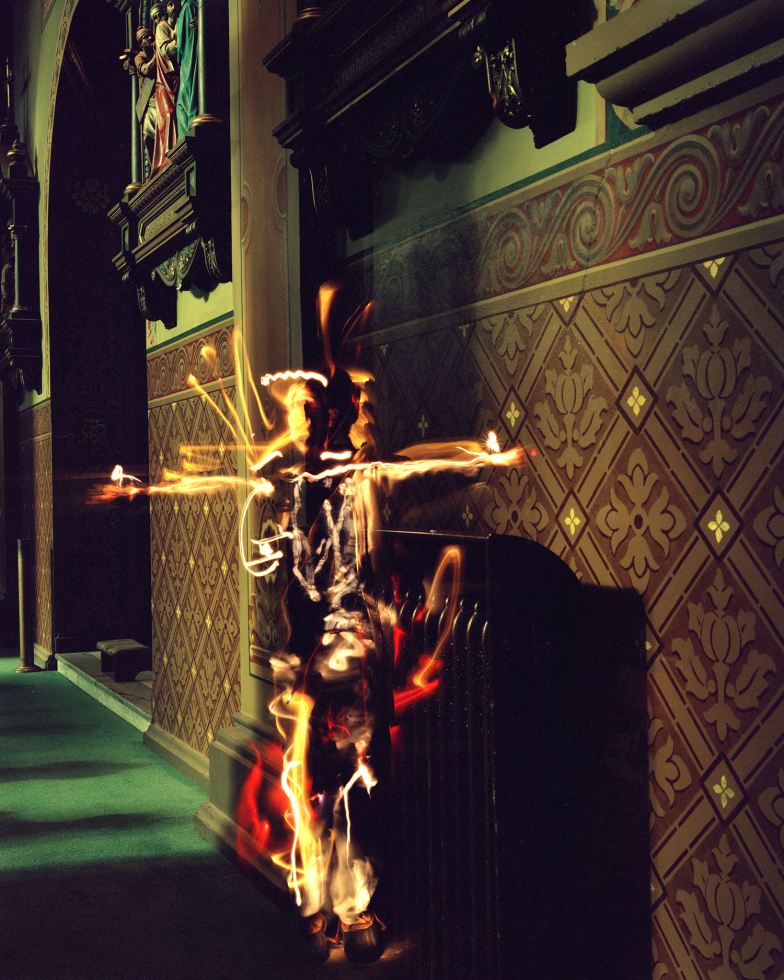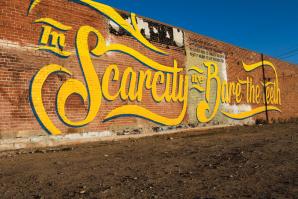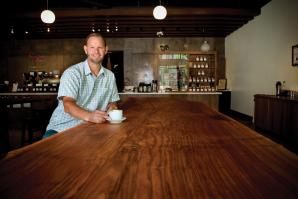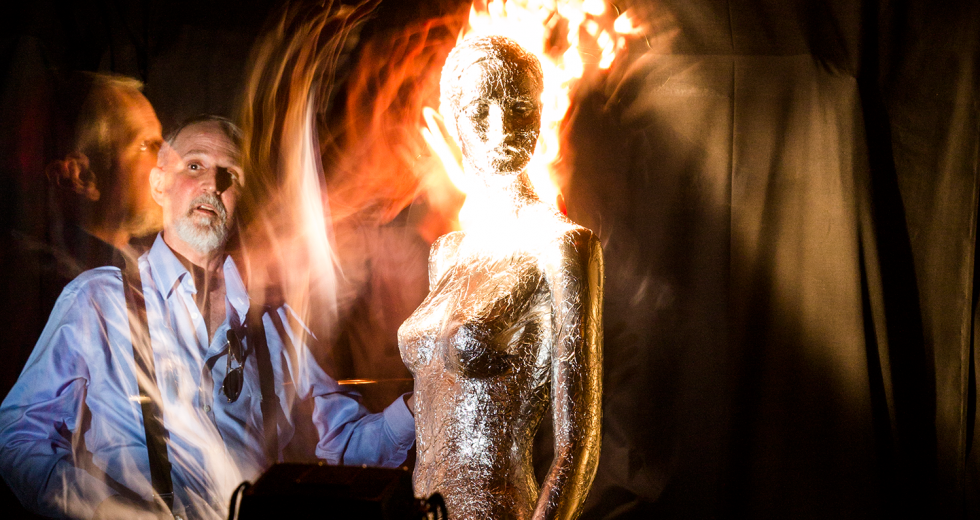Pete Eckert’s professional life is immersed in images. As a photographer, his work is hauntingly ephemeral. Layered exposures and dancing light create photos that compel viewers to pause, to make sense of what they are seeing. His work has caught the attention of Swarovski, the U.S. Postal Service and fine art enthusiasts worldwide.
The photos are also a way for Eckert, who, at the age of 57, has been blind for roughly half his life, to communicate with the sighted world through art.
“My work has a quiet message,” says Eckert, with his retired guidedog Clancy asleep at his feet as Natalie Cole croons in the background of his New Era Park cottage. “If you look at the work, it stands on its own without explanation. But it does elicit a question: ‘If he can do this as a blind person, what can all of those other disabled people do?’”
Eckert was 26 when a doctor diagnosed him with retinitis pigmentosa, a degenerative eye disease, before quietly slipping out of the room without further explanation. It wasn’t until later, while listening to Dr. Dean Edell discuss RP on a television program, that Eckert learned the condition would eventually render him completely blind.
“It’s a very hard diagnosis to give somebody,” Eckert says, “that they’re going to go totally blind. How do you deliver that sledgehammer blow? So I don’t slight the doctor for walking out of the room. Doctors have emotions, too.”
Clancy, as if sensing the shift in mood, sits up to nuzzle his master. “It was staggering,” Eckert says. “It took me two years to recover.”
Within nine months of Eckert’s diagnosis, he had lost 50 percent of his vision. But he had a plan. Always an artist and designer at heart, Eckert had a diploma in sculpture and ceramics from the Art Institute of Boston. He’d also earned two Bachelor of Arts degrees, one in sculpture and the other in design and industry, at San Francisco State University before heading to Connecticut to be near his family.
Eckert had intended to pursue his master’s in architecture but, with blindness looming, decided to switch courses and pursue an MBA. Employment wasn’t Eckert’s only concern. He also worried about how, as his sight deteriorated, he would defend himself. So in addition to his studies, he also trudged nightly through the Connecticut snow to his dojo. Eckert has studied a variety of martial arts forms, and has a blackbelt in tae kwon do.
“I had two objectives,” he says. “I wanted to be able to defend myself, and I wanted to make money.”
“Stations.” Photo courtesy of Pete Eckert

According to the American Federation for the Blind, about 75 percent of working-age people (ages 16 to 64) in the blind community are considered “not in the labor force” as of January 2014. Thirteen percent of the working-age, visually-impaired population is unemployed. Not only are the numbers staggering, but they’ve also remained relatively stagnant over the past decade, despite the evolution of technologies that allow those experiencing vision loss to adapt professionally.
“[The unemployment rate] has remained relatively stable,” says Shari Roeseler, executive director for the Society for the Blind. “That’s why agencies have put an emphasis on blindness skills and adaptive technology.”
The Society for the Blind doesn’t just provide resources for those living with blindness and vision loss, but for the area businesses who do (or should) employ them. “Businesses don’t always know that there are adaptive technologies and software to keep a person employed.”
The statistics mirror Eckert’s efforts in the job market. After he graduated from the University of Hartford with his MBA in 1989, he pursued jobs in finance. Having graduated at the top of his class, he considered himself a pretty worthy candidate — but no job offers came.
“People loved me when I had a little bit of vision,” he says. “Then I told them I would eventually go blind. This was before the ADA, and I was completely undefended. A lot of the things people were saying were illegal, and they could get away with it.”
Having left behind the snowy Connecticut winters to return to the West Coast, Eckert returned to his artistic passions. He taught himself to work with a lathe, crafting ornate, 18th-century-style hardwood clocks encased in stained glass. When Amy, his wife, would return home from work, he would be waiting eagerly for her to check his progress. Unfortunately, that progress was slow, and Eckert was only able to craft about two per year.
“I could make marvelous clocks, delightful, but the amount of time it would take me to do them, I couldn’t make a dime.” He smiles. “The MBA did rub off on me some.”
Photography had always been an interest, and now it offered a greater bang for Eckert’s proverbial buck. He currently works with four different cameras (two Mamiyas, one a twin lens reflex and the other an RB67 pro; a Toyo 4×5 view camera; and an old, 1920s-style 4×5 pinhole wooden camera). He is familiar with each piece and the devices’ respective processes. He has no assistant. Eckert adjusts aperture and shutter speed by listening for clicks and by counting ticks as he makes adjustments. He tracks the distance in footsteps between subject and tripod and turns a keen ear to gauge his surroundings. He’s training his new guidedog, a white German shepherd named Hunter, to guard his equipment the way his prior guidedogs have. Eckert has never had a single piece of equipment stolen or damaged on the streets of midtown Sacramento, where he does a lot of his shooting.
Eckert says he sees his process more as molding than capturing. “Other photographers go out, and they’re behind the camera, grabbing images from the outside. I’m pushing images from the inside out. I’m building images.”
Last year, Eckert caught Swarovski’s attention and was flown to Europe to shoot a line of their baubles in preparation for the LINK Jewelry Summit in Vienna. Last May, he spoke at the Seoul Digital Forum. The NBC television series NCIS based a character on him, one of his photographs was created as a United Nations postage stamp, and he has even shot for Playboy.
Eckert hopes both his publicity and the images he constructs will serve as the starting point for dialogue on the capabilities of not just the blind community, but all of those living with a disability.
“I’m not special,” he says. “There’s a lot of really brilliant blind people and people with other disabilities who haven’t been given the chance to even start.”
Sick of missing out? Sign up for our weekly newsletter highlighting our most popular content. Or take it a step further and become a print subscriber — it’s both glossy and affordable!
Recommended For You

Words of Art
Shabby neighborhoods are being brought to life with public art
Public art is about more than intricate town square sculptures or decorative murals that mask the walls of blight. At its best, public art doesn’t simply beautify a space, it engages a community by reflecting and helping to define the environment around it.

Art Elevated
Local muralists seek to set precedent for public art
Few of the thousands of shoppers at Sacramento’s Sunday farmers market at 8th and W streets ever look up at the gray concrete ceiling looming above them. But by next spring, it may be tough to look at anything else.

What’s Eating Tim Collom?
A success in art and realty, Tim Collom still can’t relax
“Something isn’t quite right with Tim Collom. On the outside, Collom is doing far better than most of us. In the past year, he has been featured on KCRA-TV and HGTV speaking about real estate and in the pages of The Sacramento Bee and Sacramento Magazine showcasing his paintings.

Money Tree
New Helvetia Hardwoods is homegrown
Tree aficionado Clark Kayler rescues fallen elms, walnuts, sycamores and redwoods — giants that have lined the streets of midtown Sacramento for more than 100 years — and grants them new life in the form of furniture.




Comments
Amazing and inspiring. I will remember this fellow when I think "I can't." He can and does. Amazing.
Incredible story; very well written